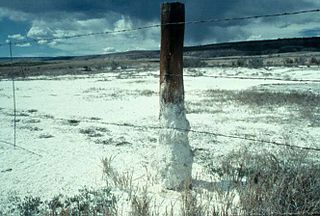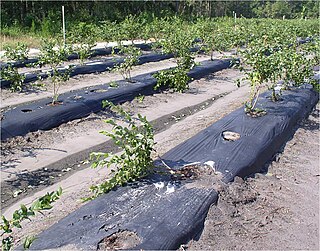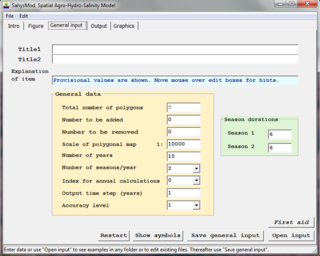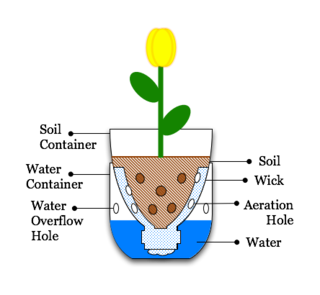Related Research Articles

Hydroponics is a type of horticulture and a subset of hydroculture which involves growing plants, usually crops or medicinal plants, without soil, by using water-based mineral nutrient solutions. Terrestrial or aquatic plants may grow with their roots exposed to the nutritious liquid or the roots may be mechanically supported by an inert medium such as perlite, gravel, or other substrates.

Irrigation is the practice of applying controlled amounts of water to land to help grow crops, landscape plants, and lawns. Irrigation has been a key aspect of agriculture for over 5,000 years and has been developed by many cultures around the world. Irrigation helps to grow crops, maintain landscapes, and revegetate disturbed soils in dry areas and during times of below-average rainfall. In addition to these uses, irrigation is also employed to protect crops from frost, suppress weed growth in grain fields, and prevent soil consolidation. It is also used to cool livestock, reduce dust, dispose of sewage, and support mining operations. Drainage, which involves the removal of surface and sub-surface water from a given location, is often studied in conjunction with irrigation.

Soil salinity is the salt content in the soil; the process of increasing the salt content is known as salinization. Salts occur naturally within soils and water. Salination can be caused by natural processes such as mineral weathering or by the gradual withdrawal of an ocean. It can also come about through artificial processes such as irrigation and road salt.

Evapotranspiration (ET) is the combined processes which move water from the Earth's surface into the atmosphere. It covers both water evaporation and transpiration. Evapotranspiration is an important part of the local water cycle and climate, and measurement of it plays a key role in agricultural irrigation and water resource management.

Plastic mulch is a product used in plasticulture in a similar fashion to mulch, to suppress weeds and conserve water in crop production and landscaping. Certain plastic mulches also act as a barrier to keep methyl bromide, both a powerful fumigant and ozone depleter, in the soil. Crops grow through slits or holes in thin plastic sheeting. Plastic mulch is often used in conjunction with drip irrigation. Some research has been done using different colors of mulch to affect crop growth. Use of plastic mulch is predominant in large-scale vegetable growing, with millions of acres cultivated under plastic mulch worldwide each year.
Drip irrigation or trickle irrigation is a type of micro-irrigation system that has the potential to save water and nutrients by allowing water to drip slowly to the roots of plants, either from above the soil surface or buried below the surface. The goal is to place water directly into the root zone and minimize evaporation. Drip irrigation systems distribute water through a network of valves, pipes, tubing, and emitters. Depending on how well designed, installed, maintained, and operated it is, a drip irrigation system can be more efficient than other types of irrigation systems, such as surface irrigation or sprinkler irrigation.

Nutrient management is the science and practice directed to link soil, crop, weather, and hydrologic factors with cultural, irrigation, and soil and water conservation practices to achieve optimal nutrient use efficiency, crop yields, crop quality, and economic returns, while reducing off-site transport of nutrients (fertilizer) that may impact the environment. It involves matching a specific field soil, climate, and crop management conditions to rate, source, timing, and place of nutrient application.

Aeroponics is the process of cultivating plants in an air or mist environment, eliminating the need for soil or an aggregate medium. The term "aeroponic" originates from the Greek words aer ("air") and ponos ("work"). It falls under the category of hydroponics, as water is employed in aeroponics to deliver nutrients to the plants.
Subirrigation also known as seepage irrigation, is a method of irrigation where water is delivered to the plant root zone. The excess may be collected for reuse.
Soil moisture is the water content of the soil. It can be expressed in terms of volume or weight. Soil moisture measurement can be based on in situ probes or remote sensing methods.

Surface water is water located on top of land, forming terrestrial waterbodies, and may also be referred to as blue water, opposed to the seawater and waterbodies like the ocean.

SahysMod is a computer program for the prediction of the salinity of soil moisture, groundwater and drainage water, the depth of the watertable, and the drain discharge in irrigated agricultural lands, using different hydrogeologic and aquifer conditions, varying water management options, including the use of ground water for irrigation, and several crop rotation schedules, whereby the spatial variations are accounted for through a network of polygons.

Surface irrigation is where water is applied and distributed over the soil surface by gravity. It is by far the most common form of irrigation throughout the world and has been practiced in many areas virtually unchanged for thousands of years.

Water resources are natural resources of water that are potentially useful for humans, for example as a source of drinking water supply or irrigation water. 97% of the water on Earth is salt water and only three percent is fresh water; slightly over two-thirds of this is frozen in glaciers and polar ice caps. The remaining unfrozen freshwater is found mainly as groundwater, with only a small fraction present above ground or in the air. Natural sources of fresh water include surface water, under river flow, groundwater and frozen water. Artificial sources of fresh water can include treated wastewater and desalinated seawater. Human uses of water resources include agricultural, industrial, household, recreational and environmental activities.

Soil moisture sensors measure the volumetric water content in soil. Since the direct gravimetric measurement of free soil moisture requires removing, drying, and weighing of a sample, soil moisture sensors measure the volumetric water content indirectly by using some other property of the soil, such as electrical resistance, dielectric constant, or interaction with neutrons, as a proxy for the moisture content.

Sub-irrigated planter (SIP) is a generic name for a special type of planting box used in container gardening and commercial landscaping. A SIP is any method of watering plants where the water is introduced from the bottom, allowing the water to soak upwards to the plant through capillary action. It is possible to automate the watering and thus SIPs are popular with professional landscapers in buildings or urban settings. Commercialized versions of a Sub-irrigated planter condenses humidity from the environment and feed it directly into the plants' roots. SIPs are available as commercial products or as do-it-yourself projects made from plastic buckets, boxes or storage totes. One of the disadvantages of such closed systems is that soluble salts cannot be flushed into the lower soil profile and build up over time.
The term cropping system refers to the crops, crop sequences and management techniques used on a particular agricultural field over a period of years. It includes all spatial and temporal aspects of managing an agricultural system. Historically, cropping systems have been designed to maximise yield, but modern agriculture is increasingly concerned with promoting environmental sustainability in cropping systems.
Sustainable landscaping is a modern type of gardening or landscaping that takes the environmental issue of sustainability into account. According to Loehrlein in 2009 this includes design, construction and management of residential and commercial gardens and incorporates organic lawn management and organic gardening techniques.

Tomato grafting is a horticulture technique that has been utilized in Asia and Europe for greenhouse and high tunnel production and is gaining popularity in the United States. Typically, stock or rootstock are selected for their ability to resist infection by certain soilborne pathogens or their ability to increase vigor and fruit yield. The scion of the grafted tomato represents the upper portion of the plant and is selected for its fruit quality characteristics. There are several methods for grafting tomatoes and they have certain advantages and disadvantages. Once the grafts are made, the plants are moved into a chamber or environment with high relative humidity (>90%) and low light levels to reduce water stress in the scion while the graft union forms.

Pulse drip irrigation is an experimental irrigation technique primarily used with drip irrigation. Maintaining a high level of soil moisture for germination of seed is one reason this technique may be used.
References
- 1 2 Lolo Houbein (2012). Outside the Magic Square: A Handbook for Food Security. Wakefield Press. p. 104. ISBN 978-1-74305-011-8 . Retrieved 7 July 2013.
- ↑ Building a Wicking Bed
- ↑ How to Build a Low-Tech, Automated Wicking Bed (AKA ‘sub-irrigated planter’)
- 1 2 "Evaluating the Efficiency of Wicking Bed Irrigation Systems for Small-Scale Urban Agriculture". ResearchGate. Retrieved 2021-07-20.
- 1 2 Semananda, Niranjani P. K.; Ward, James D.; Myers, Baden R. (December 2016). "Evaluating the Efficiency of Wicking Bed Irrigation Systems for Small-Scale Urban Agriculture". Horticulturae. 2 (4): 13. doi: 10.3390/horticulturae2040013 .
- ↑ KIRKHAM, MB; D, GABRIELS (1979). "WATER AND NUTRIENT UPTAKE OF WICK-GROWN PLANTS". Water and Nutrient Uptake of Wick-Grown Plants.
- ↑ Semananda, Niranjani P. K.; Ward, James D.; Myers, Baden R. (December 2016). "Evaluating the Efficiency of Wicking Bed Irrigation Systems for Small-Scale Urban Agriculture". Horticulturae. 2 (4): 13. doi: 10.3390/horticulturae2040013 .